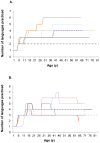Lifelong exposure to multilingualism: new evidence to support cognitive reserve hypothesis
- PMID: 23646113
- PMCID: PMC3640029
- DOI: 10.1371/journal.pone.0062030
Lifelong exposure to multilingualism: new evidence to support cognitive reserve hypothesis
Abstract
Objective: Investigate the protective effect of multilingualism on cognition in seniors.
Methods: As part of the MemoVie study conducted on 232 non-demented volunteers aged 65 and more, neurogeriatric and neuropsychological evaluations were performed. Participants were classified as presenting either cognitive impairment without dementia (CIND) or being free of any cognitive impairment (CIND-free). Language practices, socio-demographic data and lifestyle habits were recorded. In this retrospective nested case-control design, we used as proxies of multilingualism: number of languages practiced, age of acquisition and duration of practice, emphasizing the temporal pattern of acquisition, and the resulting practice of several languages sequentially or concomitantly during various periods of life. This special angle on the matter offered to our work a dimension particularly original and innovative.
Results: 44 subjects (19%) had CIND, the others were cognitively normal. All practiced from 2 to 7 languages. When compared with bilinguals, participants who practiced more than 2 languages presented a lower risk of CIND, after adjustment for education and age (odds ratio (OR) = 0.30, 95% confidence limits (95%CL) = [0.10-0.92]). Progressing from 2 to 3 languages, instead of staying bilingual, was associated with a 7-fold protection against CIND (OR = 0.14, 95%CL = [0.04-0.45], p = 0.0010). A one year delay to reach multilingualism (3 languages practiced being the threshold) multiplied the risk of CIND by 1.022 (OR = 1.022, 95%CL = [1.01-1.04], p = 0.0044). Also noteworthy, just as for multilingualism, an impact of cognitively stimulating activities on the occurrence of CIND was found as well (OR = 0.979, 95%CL = [0.961-0.998], p = 0.033).
Conclusion: The study did not show independence of multilingualism and CIND. Rather it seems to show a strong association toward a protection against CIND. Practicing multilingualism from early life on, and/or learning it at a fast pace is even more efficient. This protection might be related to the enhancement of cognitive reserve and brain plasticity, thereby preserving brain functions from alterations during aging.
Conflict of interest statement
Figures


References
-
- Ebly EM, Hogan DB, Parhad IM (1995) Cognitive impairment in the nondemented elderly. Results from the Canadian Study of Health and Aging. Arch Neurol 52: 612–619. - PubMed
-
- Premi E, Garibotto V, Alberici A, Paghera B, Giubbini R, et al. (2012) Nature versus nurture in frontotemporal lobar degeneration: the interaction of genetic background and education on brain damage. Dement Geriatr Cogn Disord 33: 372–378. - PubMed
Publication types
MeSH terms
LinkOut - more resources
Full Text Sources
Other Literature Sources
Research Materials

